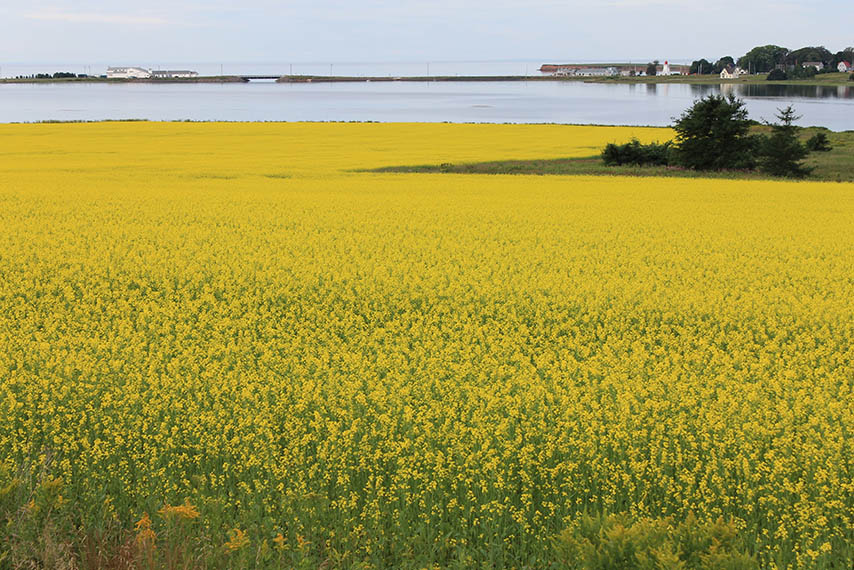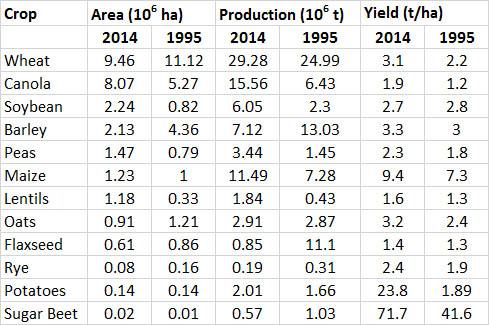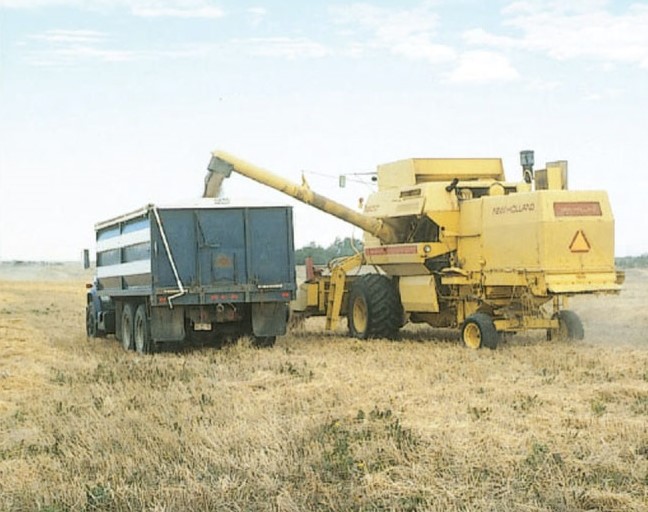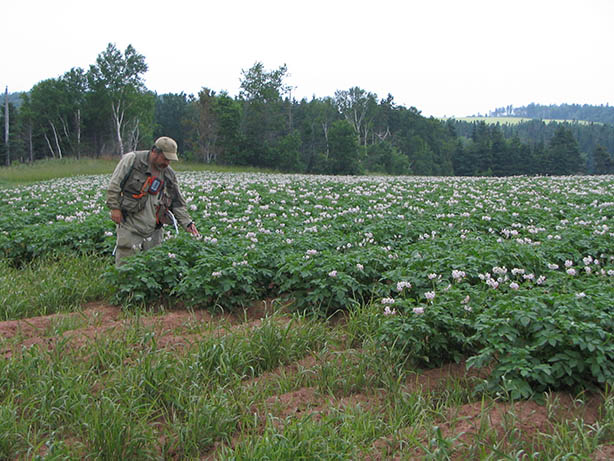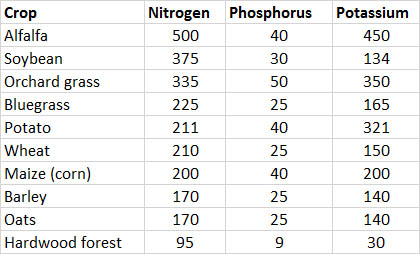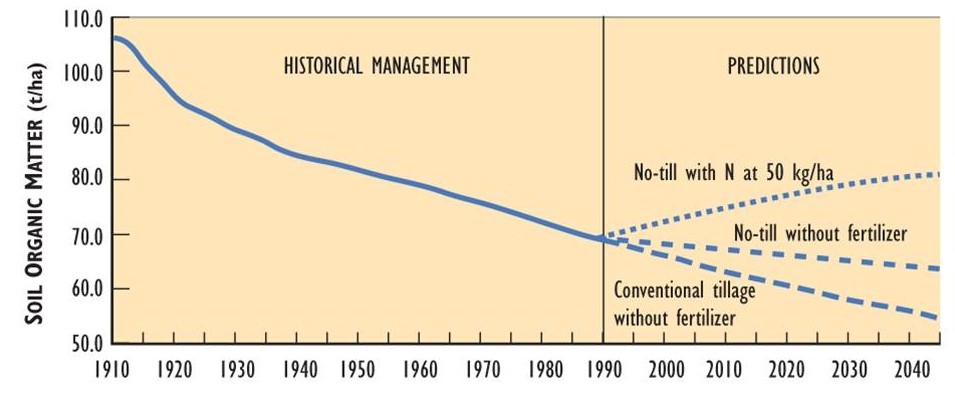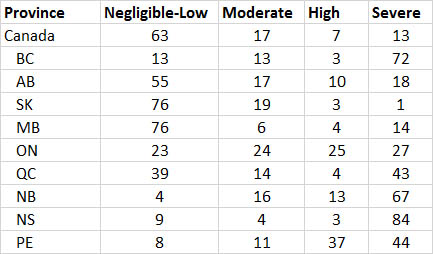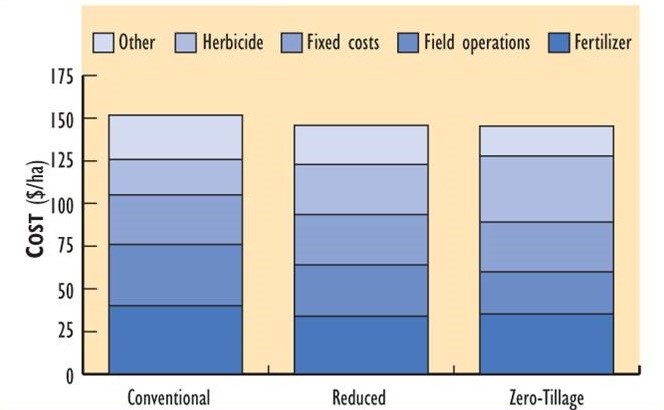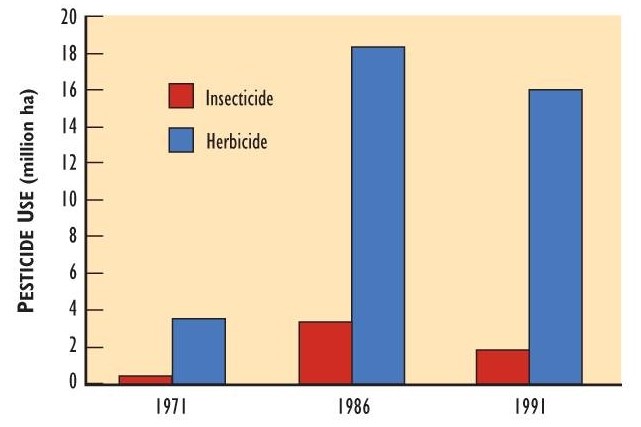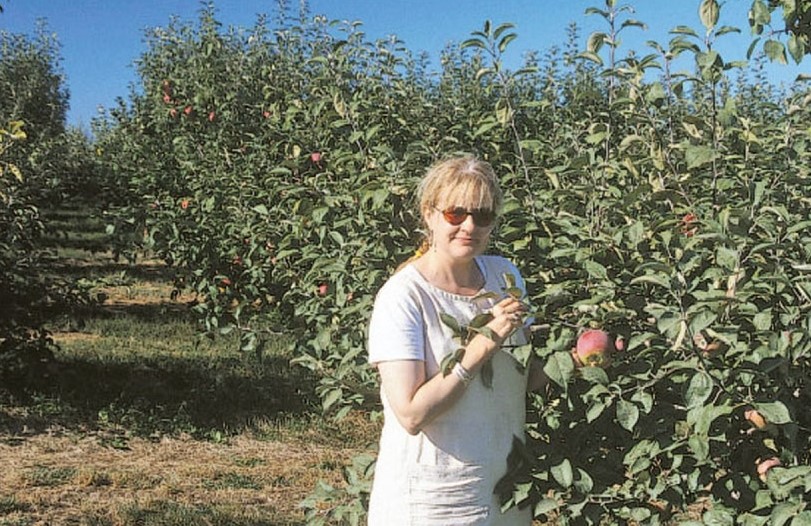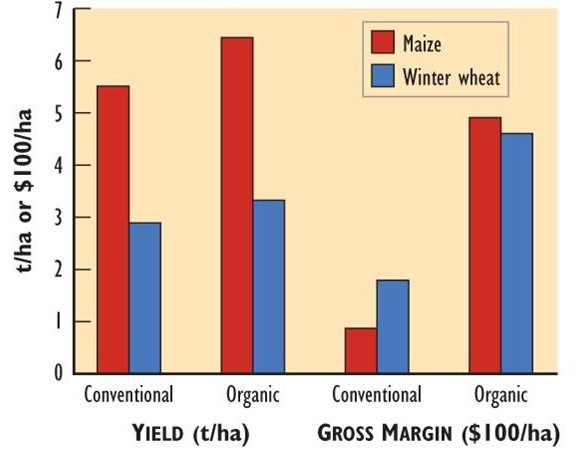Chapter 24 ~ Agriculture and the Environment
Key Concepts
After completing this chapter, you will be able to:
- Explain how agricultural production is essential to the survival of large numbers of people and domestic animals.
- Define the term “domestication,” and relate it to humans, their agricultural crops, and livestock.
- List the most important plants and animals in agriculture, and describe the management systems used in their cultivation.
- Identify the most important environmental effects of agriculture, and describe the damage that they cause.
- Explain how organic agriculture uses a more ecological approach to the cultivation of crops, resulting in less environmental damage.
Introduction
Agriculture can be defined as the science, and art, of cultivating the soil, producing crops, and raising livestock. Even relatively simple agricultural practices can greatly increase the production of food, compared with the hunting and gathering of wild animals and plants. Prior to the development of agriculture, which first appeared around 10,500 years ago, perhaps 5-10 million people were able to subsist through a hunting and gathering lifestyle. Today, the world supports an enormous population (more than 7.3 billion in 2015), and almost all depend on the agricultural production of food (fishing and hunting also provide some food). Clearly, the development of agricultural practices and technologies, and their improvements over time, are among the most crucial of the “revolutions” that have marked the socio-cultural evolution of Homo sapiens.
Agriculture was probably first practised in the Fertile Crescent, a region of southwestern Asia that includes parts of what are now Iran, Iraq, Israel, Jordan, Lebanon, Syria, and Turkey. Similar developments likely occurred at about the same time in China, although the archaeological evidence is less clear. Other cultures discovered the benefits of agriculture somewhat later, in part through the domestication of local species of plants and animals (for instance, in parts of Central America, western South America, and New Guinea). In other regions, however, domesticated species were mostly imported from elsewhere, as occurred in Australia, Europe, and North America.
In any event, beginning with the cultivation and then domestication of a few useful plants and animals, agricultural technology has advanced to the point where it is now able to support enormous populations of humans and our mutualist species (see Chapter 10).
Modern agriculture involves a number of distinct management practices. In the case of crop plants, they include: selective breeding, tillage, the use of fertilizer and pesticides, irrigation, and reaping. Each practice helps to increase the yield of biomass that can be harvested for food or other uses. The practices are typically used in various combinations, which are undertaken as an integrated system of ecosystem and species management to achieve a large production of crops. However, the management practices also cause important environmental damages.
We previously examined agricultural production and economics in Chapter 14. In this chapter we investigate environmental damages that are associated with agriculture, with particular attention to effects that occur in Canada. We will examine the intensive cultivation of crop plants and livestock, as well as softer management practices that are used in organic agriculture.
Crop Plants
Almost all of the important agricultural crops have been domesticated. Domestication refers to the progressive modification of crops through the selective breeding of cultivated races (or cultivars), which are now genetically, anatomically, and physiologically different from their wild ancestors. Crop plants have been selectively bred to increase their yield and response to management practices and to enhance their palatability. In some cases, thousands of years of domestication have resulted in crop plants that bear so little resemblance to their wild ancestors that they are now incapable of maintaining themselves in the absence of management by people. For example, several millennia of selective breeding of maize (corn; Zea mays) have resulted in its cob becoming tightly wrapped within leafy bracts. As a consequence, its seeds are no longer able to scatter from the cob, so they cannot germinate and develop new plants unless assisted to do so by humans.
A few crop plants have not yet been domesticated. One example is the lowbush blueberry (Vaccinium angustifolium), which has been cultivated for only a few decades. In this case, the habitat of wild plants (in the genetic sense) is being managed to increase their abundance and fruit production as a perennial crop. Because not much selective breeding has been conducted, the blueberry is not yet a domesticated plant. Most crop plants are grown as food, while others are sources of fibre, fuel, or medicine. Important domesticated food plants include the following:
- Small grains: barley (Hordeum vulgare), maize (corn, Zea mays), millet (Panicum miliaceum), oats (Avena sativa), rice (Oryza sativa), sorghum (Sorghum vulgare), wheat (Triticum aestivum and T. durum)
- Legumes (pulses): broad bean (Vicia faba), garden bean (Phaseolus vulgaris), garden pea (Pisum sativum), lentil (Lens culinaris), peanut (Arachis hypogaea), soybean (Glycine max)
- Sweet fruits: apple (Malus domestica), banana (Musa sapientum), grape (Vitis vinifera), grapefruit (Citrus maxima), mango (Mangifera indica), orange (Citrus sinensis), peach (Prunus persica), pear (Pyrus communis), plum (Prunus domestica), raspberry (Rubus idaeus), strawberry (Fragaria virginiana and F. chiloensis), sweet cherry (Prunus avium), watermelon (Citrullus lanatus)
- Vegetable fruits: cucumber (Cucumis sativus), pumpkin (squash, Cucurbita pepo), red pepper (Capsicum annuum), tomato (Lycopersicon esculentum)
- Roots and tubers: beet (Beta vulgaris), carrot (Daucus carota), garlic (Allium sativum), onion (Allium cepa), parsnip (Pastinaca sativa), potato (Solanum tuberosum), radish (Raphanus sativus), sweet potato (Ipomoea batatas), turnip (Brassica rapa)
- Vegetables: asparagus (Asparagus officinalis); broccoli, cabbage, cauliflower (all varieties of Brassica oleracea); celery (Apium graveolens); lettuce (Lactuca sativa); spinach (Spinacia oleracea)
- Edible oils: canola (or rape, Brassica napus), oil palm (Elaeis guineensis), olive (Olea europaea), peanut, soybean
- Sugar crops: sugar beet (Beta vulgaris), sugar cane (Saccharum officinarum)
- Herbs and spices: chili pepper (Capsicum annuum), mint (Mentha spp.), pepper (Piper nigrum)
- Beverages: cocoa (Theobroma cacao), coffee (Coffea arabica), cola (Cola acuminata), hops (Humulus lupulus), tea (Camellia sinensis)
- Recreational drugs: cannabis (marijuana, Cannabis sativa), coca (Erythroxylum coca), opium poppy (Papaver somniferum), tobacco (Nicotiana tabacum)
Other domesticated plants are cultivated as sources of fibre, which is used to manufacture thread, woven textiles, cordage (such as rope), and paper. Important fibre plants include cotton (Gossypium hirsutum), flax (Linum usitatissimum), and hemp (Cannabis sativa). Some species of trees, such as pines (Pinus species), poplars (Populus spp.), Douglas-fir (Pseudotsuga menziesii), and spruces (Picea spp.), are grown in plantations (called agroforestry) as sources of fibre. However, these species have not been selectivel bred to the degree that they would be considered domesticated.
A few plants are grown for the production of bio-energy, such as maize, sugar cane, and other carbohydrate-rich crops that are fermented to manufacture industrial ethanol used to power motor vehicles (as a mixture with gasoline known as gasohol).
Other crops are grown as sources of rubber (especially para rubber, Hevea brasiliensis), for medicinal purposes (such as digitalis, Digitalis purpurea), as chewing gum (chicle, Achras zapota), as dyes (indigo, Indigofera tinctoria), or for other relatively minor uses.
Image 24.1. Agricultural plants are usually intensively managed to develop a monoculture, which is an ecosystem comprised almost entirely of a single crop. This field of canola is in Prince Edward Island. Source: B. Freedman.
The parts of plants that are used for food include seeds (beans, wheat, and other grains and pulses), flowers (broccoli), fruits (melons, grapes, tomato), leaves (lettuce, cabbage), stems (asparagus, celery), and roots, tubers, and other underground tissues (onion, potato, radish). In many cases, the edible parts are tissues that evolved to store energy for the plant, such as swollen leaves and stems, and tubers. In other cases, the edible parts are energy-rich tissues that are involved in sexual reproduction, such as fruits and seeds. An important aspect of the domestication process is the selective breeding of crops to exaggerate their desirable traits, which usually results in cultivars that are very different from their wild ancestors.
Production of Crops
The above lists suggest a rich diversity of crop species. We must remember, however, that the inventory of cultivated plants is only a tiny fraction of the number of species that are potentially useful as foods or for other purposes, but have not yet been investigated for their usefulness (there are about 250-thousand species of vascular plants, but only tiny faction of them most have been investigated for their usefulness; Table 7.1).
Overall, people eat several thousand species of plants, of which about 200 have been domesticated. Of these, only 12 species account for about 80% of global food production (Diamond, 1999). They are:
- five cereals: wheat, maize, rice, barley, and sorghum
- one pulse: soybean
- three root or tuber crops: potato, manioc, and sweet potato
- two sweeteners: sugar cane and sugar beet
- the soft fruit banana Of these top-12 crops, the cereals account for about half of the calories that are consumed.
As we examined in Chapter 14, the cultivation of agricultural crops is an extremely important economic activity. The Canadian production of cereal crops was 66.4-million tonnes in 2013 (a 31% decrease from a decade earlier), while that of root and tuber crops was 4.6-million tonnes (14% decrease), and meat 4.5-million tonnes (7% increase) (FAO, 2015). The most important plant crops grown in Canada are listed in Table 24.1. Note the general increase in crop productivity (yield) during the 20-year period, due to an intensification of management practices. Note also the large increases in the production of certain crops, in particular canola, lentils, peas, and soybean. The production of wheat, barley, and maize also increased, partly in response to improved opportunities to export these commodities.
Table 24.1. The Production of Leading Plant Crops in Canada over a 20-year period (in 2014 and 1995). Crops are listed in order of decreasing area harvested. Source: Data from Statistics Canada (2014a,b).
Management Systems
Various management practices and systems, which vary greatly in their intensity, can be applied to the cultivation of any crop plant (or to livestock). The most intensive systems may involve cultivating a monoculture (only one crop species) using a series of such practices as tilling the soil, planting, applying fertilizer and pesticide, and a harvest when the crop is ripe. Intensive agricultural systems are typically used on relatively large farms and they rely on specialized, fossil-fuelled machinery (known as mechanization). Intensive systems may also be used on smaller farms in order to achieve higher production on a limited area of land.
The use of intensive agricultural systems is common in relatively developed countries, such as Canada. It also occurs in plantation-style agriculture in less-developed countries, where commodities are grown mostly for an export market. In contrast, subsistence farming, as is commonly practised by poor people in less-developed countries, involves little or no use of fertilizer or pesticide and no mechanization. So-called organic agricultural systems used in developed countries also eschew the use of synthetic fertilizer and pesticides (this approach to farming is examined in detail later in this chapter).
Key practices for growing crop plants in intensively managed systems include the following:
- selective breeding of crop varieties for higher yield, greater response to management practices, adaptation to local climatic or soil conditions, and resistance to disease or herbicide
- tilling the soil so that seeds can establish and to reduce competition from weeds
- planting the crop at an optimal spacing, usually as a monoculture, to increase productivity and the ease of harvesting
- applying inorganic fertilizer or organic matter (including animal dung) to enhance the nutrient supply
- irrigating to enhance the availability of water
- controlling weeds by mechanical means (such as tillage) or by the use of herbicide
- controlling invertebrate pests using pesticide (most commonly insecticide or nematicide), by introducing diseases or predators of the pests, or by managing the habitat to make it less suitable for them
- controlling fungal pathogens by using fungicide or by managing habitat to make it less suitable
- harvesting the crop biomass as efficiently as possible
- developing crop-rotation systems that maintain site quality and help prevent the build-up of pests and pathogens
- using mechanized systems to till the soil, plant seed, apply fertilizer and pesticide, and harvest the crop
- cultivating some crops, such as tomato and cucumber, in greenhouses
- developing so-called organic systems that maintain high crop yields while reducing or eliminating the use of synthetic fertilizer and pesticide
As we noted previously, intensive management systems vary greatly among crop species and among regions, and it is far beyond the scope of this chapter to describe such systems in detail. Nevertheless, we can get an idea of what an intensive system can involve by examining case studies dealing with selected crops (see Canadian Focus 24.1, 24.2, and 24.3). Practices used in organic agriculture are examined later in this chapter.
Canadian Focus 24.1. Growing Wheat on the Prairies Wheat is the most important crop grown in Canada, ranking first in both area under cultivation (average of 9.5-million hectares sown during 2010-2014) and harvest (28.5-million tonnes annually during the same period). Most wheat is grown on large, mechanized farms in the Prairie Provinces. The management system used depends on the climatic zone and soil type. The practices described here are recommended for spring-planted wheat in the dark-brown soil zone of Saskatchewan (Saskatchewan Agriculture and Food, 2014).
- Tillage: No ploughing is recommended, and instead the wheat is directly seeded into the soil using specialized tractor-drawn machinery.
- Choosing the Variety: Different varieties are used in the various climatic regions of the Prairie Provinces (about eight varieties are commonly grown). Each is bred to be adapted to local growing conditions, responsive to management practices, and resistant to diseases and pests.
- Planting: Wheat seeds are directly planted through the stubble of the previous crop (the over-wintering crop residues help to prevent erosion, conserve soil moisture, and add organic matter to the soil). The recommended planting rate is 0.11 m3 of seed per hectare.
- Fertilizer: Inorganic fertilizer is added at a rate of 50 kg nitrogen per hectare and 25 kg phosphorus/ha.
- Weed Control: One or more herbicide applications are required, including a pre-planting treatment with glyphosate.
- Pathogens: Various fungal pathogens may affect wheat, including stem rust (Puccinia graminis tritici), loose smut (Ustilago tritici), and powdery mildew (Erysiphe graminis). These may be controlled by planting resistant varieties, by the use of cultivation practices that make the habitat less suitable for the pathogen, and by using fungicide. Wheat is also susceptible to bacterial pathogens such as leaf blight (Pseudomonas syringae), which are managed by using disease-free seed and by growing wheat in rotation with other crops.
- Insect Control: Pest insects include irruptions of grasshoppers (Melanoplus spp.) and the orange wheat-blossom midge (Sitodiplosis mosellana). One or more insecticide treatments may be required. Some pests can be controlled by cultivation practices, including residue management and growing wheat in rotation with other crops.
- Harvesting: Wheat is harvested using specialized combine harvesters.
- Other Considerations: This management system should be a component of a crop rotation, such as: grow canola in year 1, spring wheat in year 2, lentils in year 3, durum wheat in year 4, and summer fallow in year 5,. There is no tillage except at the beginning of year 1 (canola); all other crops are direct-seeded. The practice of direct-seeding helps to reduce erosion.
Image 24.2. Farming in Canada mostly involves intensively managed, mechanized operations. This photo shows a combine harvesting wheat in Alberta. Source: M. Willison.
Canadian Focus 24.2. Growing Potatoes in the Maritimes One of the most intensive management systems used in Canada involves the cultivation of potatoes in the Maritimes, particularly in Prince Edward Island and New Brunswick. The practices described below are typically used on relatively large, mechanized farms (Atlantic Potato Committee, 1993).
- Tillage: The first tilling is done before planting to break up the soil and facilitate drainage and aeration. This may be done in late autumn or early spring. Tilling in the spring avoids some of the erosion occurs if sloped fields are ploughed in the autumn and left without a cover of crop residue or winter rye. However, spring tilling requires that the fields be dry enough to support heavy machinery, so it often results in a later seeding and less growing time for the crop. A lighter, secondary tillage prepares the seedbed and is followed by periodic between-row tillage to reduce the abundance of weeds as the crop grows.
- Choosing the Variety: Specific varieties are grown, with the choice depending on site conditions and whether the crop is to be used as table potatoes, to process into frozen fries or potato chips, or to be used as “seed” (see below). About 20-25 varieties are cultivated in the Maritimes (of which six-eight comprise about 80% of the crop). However, this is only a fraction of the diversity of the potato – hundreds of local cultivars are grown in the Andean highlands, where this crop was first domesticated.
- Preparing the “Seed”: Potatoes are grown from slices of a tuber that contains several “eyes” (a bud from which a shoot can sprout). The “seed” is surface-sterilized and dusted with fungicide to prevent soft rot and other diseases. This is a vegetative (or clonal) means of propagation that results in plants being genetically identical.
- Planting: Once the soil temperature exceeds 7°C, seed potatoes are planted 15-40 cm apart and 8-13 cm deep, in rows 90 cm apart, and overall equivalent to a density of 28-74/m2. A wider spacing is used for food crops and a closer one for seed potatoes. A tractor-drawn planter is used in the planting.
- Fertilizer: Potatoes are a “soil-depleting” crop, so fields must be treated with fertilizer, typically at 800-1000 kg/ha-year with a 15-15-15 NPK fertilizer (this means that the fertilizer contains 15% each of nitrogen, phosphorus, and potassium). Fertilizer is applied when the seed is planted and often during the growing season as well
- Liming: The optimum soil pH is 5.5-6.0, largely to prevent fungal disease. This pH range is maintained by adding agricultural lime or crushed limestone.
- Weed Control: Weeds are controlled by between-row tillage, which is done several times during the growing season. Herbicide may also be used, typically one spray per year.
- Fungal Pathogens: Late blight (Phytopthora infestans) can destroy potato crops, and it is controlled by growing resistant varieties, destroying waste tubers, and spraying fungicide. Other fungal diseases are early blight (Alternaria solani), verticillium wilt (Verticillium spp.), and pathogens that cause stored tubers to rot. These are controlled with fungicide and by using cultivation practices that develop conditions that are less favourable to the pathogens. A range of 5-15 fungicide treatments are required per year, depending on the severity of the problem.
- Other Pathogens: Bacterial and viral diseases are controlled by growing disease-free seedstock and by using cultivation practices that are less favourable to the pathogens.
- Pest Control: The Colorado potato beetle (Leptinotarsa decemlineata) is the most important pest, but other beetles, aphids, and additional insects may also cause damage. Typically 2-5 sprays of an insecticide are needed per year. The root-lesion nematode (Pratylenchus neglectus) and other nematodes are controlled by crop rotation or by fumigation with a nematicide.
- Top-Killing: This aid to harvesting involves one or two late-season sprays with a non-systemic herbicide to kill the potato vines and to induce the tubers to form a firmer skin, which gives them a degree of protection during harvesting and storage. Although the vines will die back naturally, top-killing with herbicide allows for a controlled timing of the harvest.
- Harvesting: Specialized tractor-drawn machinery is used to harvest potatoes, typically four rows at a time.
- Other Considerations: Continuous cultivation of potatoes results in a depletion of tilth and organic matter, compaction by machinery, erosion from slopes, and a buildup of pathogens and pests. Consequently, potatoes are best grown in a three-year rotation with a cereal and forage crop. Measures to enhance soil organic matter are recommended, such as adding manure, leaving crop residues, and using a green-manure crop in the rotation. Although potatoes can be grown without pesticide, this is considered impractical in industrial agriculture.
Image 24.3. A field of potatoes in flower in Prince Edward Island. Source: B. Freedman.
Livestock
Livestock are raised primarily as sources of food. The most important domesticated livestock in Canada are the cow (Bos taurus), horse (Equus caballus), pig (Sus scrofa), sheep (Ovis aries), and goat (Capra hircus). The most prominent birds are chicken (Gallus gallus), duck (Anas platyrhynchos), and turkey (Meleagris gallopavo). The most important fish are Atlantic salmon (Salmo salar) and rainbow trout (Oncorhyncus mykiss) – the cultivation of fish is known as aquaculture. Ranching of non-domesticated livestock, such as bison (Bison bison) and elk (Cervus elaphus), is also increasing.
Livestock in developed countries are mostly grown under intensive management systems. In large part this involves rearing animals on “factory farms,” although beef cattle may spend much of their lives foraging on rangeland, as do sheep. Key practices for growing livestock under intensive management include the following:
- selective breeding of varieties for higher yield and greater response to management practices
- developing “tame” or converted (seeded) pastures to supply fresh fodder, and hayfields for hay feeding, silage production, or bedding
- feeding livestock with concentrated foods that are manufactured from fish, slaughterhouse offal (meat “wastes”), pulses, and other products, together with mineral supplements
- using antibiotics and other medicines to prevent or treat diseases
- using growth hormones to increase production in certain animals (particularly cows)
- killing natural predators of free-ranging livestock, such as bear, cougar, coyote, and wolf
- confining livestock in dense feedlots or factory farms, with feeding to satiation and other intensive husbandry practices
- developing organic systems that maintain high yields of livestock, while reducing or eliminating such intensive practices as close confinement and the routine use of medicines and growth hormones
Again, it is beyond the scope of this chapter to describe intensive management systems for livestock in detail. We can, however, examine a case study to get an idea of what the systems may involve (Canadian Focus 24.3).
Canadian Focus 24.3. Raising Livestock on Factory Farms Enormous numbers of animals are raised in Canada to provide meat, milk, eggs, and other products. In 2013, about 167-million chickens were slaughtered, as were 5.7-million turkeys. The most important livestock are cows (16 million including 2-million milk cows) and pigs (26 million) (Chapter 14).
To increase productivity, most poultry, cows, and pigs are reared on “factory farms” in extremely crowded quarters, with feeding to satiation, plus other intensive practices. (However, many cows spend much of their life on rangeland or pasture, being kept under close confinement only during a “finishing” phase of rapid growth in a feedlot before slaughter.)
Because of the obvious potential for treating animals cruelly under such conditions, livestock rearing on factory farms is a controversial practice. Animal-rights groups protest against the conditions imposed on livestock during rearing, transportation, and slaughter. In addition, many people choose to not purchase foods from factory farms, or they have adopted a vegetarian lifestyle in order to not participate in what they consider an inhumane economic activity. Partly because of these protests, factory farms have become well-guarded facilities with tightly controlled access.
Agriculture Canada, the Canadian Federation of Humane Societies, and food-industry associations have developed guidelines for the acceptable treatment of livestock in our country. The following is a list of recommended practices for rearing livestock; all are routinely used on industrial farms and are considered “acceptable” by regulators (Agriculture Canada, 1989, 2009, 2013).
Poultry
- The distal third of the beak and tips of the toes may be amputated to prevent injuries from fighting under close confinement.
- Non-saleable chicks may be euthanized by maceration (grinding), lethal exposure to CO2 or CO, electrocution, or decapitation.
- Day-old chicks may be transported from a hatchery to a rearing facility in boxes containing no more than 100 chicks and providing each with a floor space of at least 21 cm2 (about four times the area of a $1 coin). The transportation should not exceed 48 hours.
- For the production of eggs by chickens living in an open pen, mature birds (up to 1.8 kg) should be provided with the equivalent of at least 0.2 m2 of space (this is three times the area of a letter-sized piece of paper). For the production of meat in an open pen, mature birds (> 3.6 kg) require 0.186 m2 each. This is considered sufficient to allow the chickens to stand, turn around, and stretch their wings. Smaller chickens may be provided with less space.
- For chickens reared in cages, mature birds (up to 2.2 kg) should have at least 0.045 m2 each (0.75 times a letter-sized paper). No more than seven adult birds should be in one cage.
- The concentration of ammonia in the air during rearing should be less than 25 ppm. (At this level, a person would experience considerable discomfort.)
Cows
- A mature dairy cow should have a space of at least 11 m2, and a pregnant cow 15 m2. These dimensions are considered sufficient to allow the cow to groom, get up and lie down, and stretch its limbs.
- Mature beef cattle that are confined in a feedlot, with paved ground and a shed for cover, should have a space of at least 4.5 m2 per animal.
- If there is no shed, the space should be at least 8 m2. A somewhat larger area is needed if the ground is not paved.
- The concentration of ammonia in the air during rearing should be less than 25 ppm.
Pigs
- Mature pigs (> 110 kg) confined in a slat-floored stall (this allows drainage of feces and urine) should be provided with a space of at least 1.8-2.2 m2 per animal. If non-slatted, there should be at least 2.0-2.4 m2 per animal. These dimensions are considered sufficient to allow the pig to get up and lie down comfortably. Smaller animals may be provided with less space.
- Breeding sows > 340 kg kept in an individual stall should have a space at least 80 cm wide and 210 cm long (1.5 m2). Smaller animals may be provided with less width.
There are also recommended practices for transporting livestock from rearing facilities to slaughterhouses, which is usually by truck or train. For example, cows and other ruminant animals can be transported for as long as 52 hours without receiving any water, food, or rest. For pigs, horses, and poultry this period is 36 hours.
Guidelines for the humane killing of animals also exist. This is usually done by electrocution, shooting, or bleeding, and sometimes by lethal injection. All of these practices are controversial because many people regard them as inhumane. Moreover, facilities for rearing, transporting, and slaughtering animals are inspected irregularly, and sometimes infrequently. This means that, in many respects, compliance with the guidelines is voluntary.
Environmental Impacts of Agriculture
Declining Site Capability
Agricultural site capability (or site quality) refers to the ability of an ecosystem to sustain the productivity of crops (Chapter 14). Soil fertility is an important aspect of this – it is related to the amount of nutrients present and to factors affecting their availability, such as drainage, tilth, and organic matter in the soil. Site quality can be degraded by agricultural practices, which may result in the erosion of topsoil, loss of organic matter and nutrients, and a buildup of weed populations. These result in decreased crop yields, which may then require intensive management practices (such as fertilizer and herbicide application) to try to compensate for the damage. Allowing site quality to degrade is a non-sustainable use of agricultural land.
Nutrient Loss
As plants grow, they take up nutrients from the soil (Table 24.2). When a crop is harvested, the nutrients contained in their biomass are removed from the site. The ability of the soil to supply nutrients may then diminish if the removals exceed the rate at which nutrients are regenerated by atmospheric deposition, nitrogen fixation, and the weathering of soil minerals.
In fact, nutrient depletion is a common problem with agricultural systems, and it is most often treated by applying inorganic fertilizer to the land. However, careful attention to the conservation of organic matter and nutrient content of soil can greatly alleviate nutrient depletion and may even eliminate the need to add inorganic fertilizer (we examine this later in the context of organic agriculture).
In any event, the use of fertilizer in agriculture has increased greatly in Canada. In 1971, fertilizer was added to about 6.9-million hectares, but this increased to 25-million hectares in 2011 (Chapter 14). Canadian fertilizer application rates are considerably lower than in some other countries: in 2012, an average of 66 kg of fertilizer was applied per hectare of agricultural land in Canada, compared with 443 kg/ha in China, 234 kg/ha in Japan, 124 kg/ha in France, and 116 kg/ha in the United States. In countries with the highest rates of fertilizer application, agricultural land is relatively valuable and property taxes are high, which creates an economic incentive to use intensive management practices to increase the productivity.
Table 24.2. Annual Uptake of Key Nutrients by Selected Crop Species. Data are in kg/ha. Sources: Data from Hausenbuiller (1985) and Atlantic Potato Committee (1993).
Often, the rate of fertilizer application is intended to satiate the needs of the crop so that its productivity is not limited by the availability of nutrients. This may result in an excess of nutrients in the soil, which may cause several environmental problems:
- pollution of the groundwater with nitrate
- eutrophication of surface waters
- acidification caused by the nitrification of ammonium to nitrate (which is followed by the leaching of nitrate)
- emission of nitrous oxide to the atmosphere
- a need to use herbicide to control the weeds that flourish under fertile conditions Fertilizers are manufactured from non-renewable resources, and large amounts of energy are used in the process. The principal sources of fertilizer are:
- urea and ammonium nitrate, which are manufactured by combining nitrogen gas with hydrogen obtained from methane (or natural gas)
- phosphate fertilizer made from mined rock phosphate
- potassium from mined potash
Organic Matter
Soil organic matter is a crucial factor that affects fertility and site capability. Organic matter has a strong influence on the capacity of soil to hold water and nutrients, and on its aeration, drainage, and tilth (see Chapter 14). Typical agricultural soil has an organic concentration of 1-10% (it can exceed 90% in the peaty substrate of drained wetlands, but this soil is uncommon in agriculture). This is considerably less than what occurs in the soil of natural prairie or forest. Those natural ecosystems have a surface layer of litter and humus, and within the mineral soil itself the concentration of organic matter is at least 15-30% higher than occurs in agricultural soil (Acton and Gregorich, 1995). Therefore, when an area of prairie or forest is converted to an agriculture use, there is a large decrease in the amount of organic matter on the surface and within the mineral soil (Figure 24.1). A depletion of organic matter is widely regarded as an important problem that affects the sustainability of agricultural production.
Figure 24.1. Changes in Organic Matter in a Prairie Soil. The data are for the surface 30 cm of soil and reflect historical management practices of annual tillage and fertilizer application. The data since 1990 show the potential effects on soil organic matter of conventional tillage without fertilizer, no-tillage without fertilizer, and no-tillage with nitrogen fertilizer at 50 kg/ha-y. Source: Modified from Acton and Gregorich (1995).
Several practices are recommended for increasing the amount of organic matter in soil. They include adding crop residues, livestock manure, or other organic-rich materials, such as composted municipal waste or sewage sludge. The use of no-tillage or low-tillage systems is also helpful, because ploughing encourages the decomposition of organic matter (no-tillage involves sowing seeds by drilling them directly into the ground without prior cultivation). The use of no-tillage in combination with fertilizer application is also effective at increasing organic matter in prairie soil (Figure 24.1). The regular addition of manure is also useful. A 50-year study in Ontario found that yearly additions of manure increased the organic matter in soil from an initial 85 t/ha to 100 t/ha, compared with 56 t/ha where no manure was applied (this is within the plough depth of the soil, about 30 cm; Environment Canada, 1996).
Soil Erosion
Soil is eroded by wind and by the runoff of rain and melted snow. Although erosion is a natural process, its rate can be greatly increased by agricultural practices, and this may be a serious environmental problem. Erosion represents a loss of soil capital, which can impoverish site capability and can cause deep gullying of fields, a damage that is almost impossible to rehabilitate. Erosion also damages aquatic ecosystems by increasing sedimentation and turbidity, which are destructive of fish habitat. Wind-eroded soil can also be a local nuisance (for example, as a source of dirt inside homes and by soiling laundry hung out to dry), and in severe cases it can literally bury machinery and buildings (as occurred on the prairies during the “dust-bowl” years of the 1930s).
Agricultural practices that increase the rate of soil erosion include the following:
- cultivating land on moderate to steep slopes
- ploughing furrows up and down slopes rather than contouring along them
- leaving fields without a cover (such as stubble or a cover-crop) during the winter
Averaged across Canada, about 20% of the cultivated land is at severe or high risk of erosion caused by flowing water. However, this varies greatly among the provinces, with British Columbia having 75% of its cultivated land in this risk category, New Brunswick 80%, and Prince Edward Island 81% (Table 24.3). Although land in the southern Prairie Provinces is at relatively low risk from water erosion, it is prone to wind-caused erosion (because there are few trees, and fields are often left bare in winter). On average, 36% of the cultivated land in the prairie region is at severe or high risk of wind erosion, and 29% is at moderate risk.
Table 24.3. Risk of Erosion by Water on Cultivated Land. Data are percent of cultivated land. Source: Data from Acton and Gregorich (1995).
Fortunately, there is an increasing use of soil-conservation practices (such as those listed below), and this is reducing the risks of erosion by wind or water:
- leaving crop residues and/or stubble in the field
- using longer crop rotations
- incorporating a forage crop into the rotation
- growing winter cover-crops (such as winter wheat)
- planting perennial shelter-belts (such as trees)
- strip-cropping
- not cultivating beside streams (leaving a riparian buffer)
- ploughing along contours rather than across them
- using no-till or low-till planting (Figure 24.2)
- maintaining perennial pastures (instead of using erosion-prone land for crops)
Figure 24.2. Costs of Tillage Systems. The data are for prairie wheat, obtained by a survey of 250 fields in Alberta during 1988–1992. Conventional tillage results in crop residues being incorporated into the soil. Reduced tillage leaves crop residues on the surface, helping to reduce erosion. Zero-tillage involves no cultivation; the crop seed is drilled into the ground. Note that the three systems have similar overall costs: $152, $146, and $145, respectively. The no-tillage system incurs higher herbicide cost because tillage helps to reduce the abundance of weeds. The greater use of herbicide is, however, offset by lower operating and fertilizer costs. There is also, of course, an environmental benefit because less erosion is caused. Source: Modified from Acton and Gregorich (1995).
Compaction
The frequent passage of heavy machinery, or the yarding of a dense livestock population, can compress the air spaces in soil, a condition known as compaction. Soil compaction is a serious problem that results in waterlogging, oxygen-poor conditions, impaired nutrient cycling, poor root growth, and decreased crop productivity. Compaction can be largely avoided by avoiding any unnecessary passages of heavy machinery over fields, using large tires to spread the load, and reducing the density of livestock kept in outdoor stockades.
Salinization
The buildup of soluble minerals in the surface soil, or salinization, is a major problem in drier regions. The most important salts are usually sulphates and chlorides of sodium, calcium, and magnesium, which in severe cases are visible as a whitish crust on the surface. Salinization occurs when there are high concentrations of salts in the soil, and the rate of evaporation exceeds the water input from precipitation. These conditions bring salts to the surface, where they are deposited as the water evaporates. Irrigation practices can also be a cause of salinization if insufficient water is added to allow dissolved salts to drain to below the rooting depth of the crop. Saline soil is toxic to most crops, largely because of interference with the uptake of water, along with ion imbalance and toxicity.
In Canada, this problem is mostly restricted to low-rainfall regions of the Prairie Provinces and to a small area in southeastern British Columbia. About 2% of the cultivated land in the Prairies has more than 15% of its area affected by salinization, while 36% has 1-15% of the area affected, and the remaining 62% has < 1% affected (Acton and Gregorich, 1995).
The control of salinization requires practices that keep the height of the water table low or prevent dissolved salts from rising. These practices include the diversion of surface flows, installation of a subsurface drainage system, using longer crop rotations (including deep-rooted forage species), practising conservation tillage, and increasing organic matter in the soil. Salt-tolerant crops may be grown on moderately salinized soil, such as barley (Hordeum vulgare) or forage plants such as alfalfa (Medicago sativa) and slender wheatgrass (Agropyron trachycaulum).
Desertification
The increasing aridity of drylands, or desertification, can make agriculture difficult or impossible. Desertification may be affecting as much as 30% of the land surface of the planet, directly affecting 250 million people and putting another billion at risk in more than 100 countries (FAO, 2007). Desertification is a complex problem, caused by both climate change and other anthropogenic influences. The latter include unsustainable land-use practices in drylands, such as over-grazing, intensive cultivation, deforestation (often to obtain fuelwood), and improper irrigation. These practices can cause the loss of topsoil and vegetation cover and a degradation of agricultural capability. These effects are greatly intensified by drought.
Desertification is largely a problem of regions that are already marginal in terms of the amounts of precipitation and soil moisture that are available to support agriculture. The best-known cases occur in less developed countries, such as dryland regions in Africa, south and central Asia, and Latin America. However, it is also an important problem in the interior regions of North America and Australia. In Canada, about 300-thousand km2 in southern Alberta and Saskatchewan are at risk of desertification. This region experienced widespread loss of topsoil by wind erosion during the drought of the 1930s, and it is still vulnerable to this degradation. The best agricultural land-use in this semi-arid region is livestock grazing on unbroken perennial range. The development of “tame” pastures and the cultivation of annual crops are more likely to cause desertification.
Pollution Caused by Agriculture
Groundwater and surface waters can become polluted by runoff containing fertilizer, pesticides, and livestock sewage. Inputs of nutrients and organic matter from fertilizer and sewage can cause severe ecological damage to surface waters through eutrophication and oxygen depletion. These changes, coupled with the presence of pathogenic and parasitic organisms, can result in waters becoming unsuitable for drinking by people, perhaps even by livestock, or for use in irrigation (see Environmental Issues 14.1).
The worst problems involve the disposal of the enormous quantities of manure that are produced by livestock kept in feedlots and factory farms. These animals produce about 181-million tonnes of manure per year, considerably more than the amount of human feces produced in Canada (2.2 million tonnes per year) (Statistics Canada, 2009). Moreover, human fecal waste is mostly treated in sewage-treatment plants (Chapters 20 and 25) rather than dumped onto agricultural land or into surface waters, as is commonly done with livestock manure.
The most important agricultural pollutant of groundwater is nitrate, which originates with manure applications to farmland and the use of fertilizer. This problem occurs because the nitrate ion (NO3–) leaches readily with water that percolates through the soil to groundwater (nitrate is highly soluble in water and is not retained by ion-exchange reactions in the soil). Nitrate pollution is a hazard for people who use groundwater as a source of drinking water. Although nitrate itself is not very toxic, it is converted by microbes in the human gut to nitrite, which when absorbed into the blood strongly binds with hemoglobin (forming a compound known as methemoglobin), thereby reducing the capacity to carry oxygen. Children are especially vulnerable to this effect; the so-called “blue-baby syndrome” refers to oxygen-starved infants who have been poisoned by nitrate in their drinking water or food.
Nitrate pollution of groundwater is a widespread problem. A study of 900 rural wells in southern Ontario found that 15% had concentrations exceeding the safe limit (the Health Canada guideline is 10 ppm of NO3-N). A study in the Okanagan Valley of British Columbia found that 33% of wells have nitrate contamination (Acton and Gregorich, 1995). In fact, nitrate exceeding hundreds of ppm (as NO3-N) has been found in groundwater in agricultural regions as a result of the application of manure and/or fertilizer. This important and extensive problem can only be resolved through more prudent fertilizer application and by prohibiting the disposal of untreated manure onto agricultural land. Manure should undergo sewage treatment, just like most human sewage does (Chapters 20 and 25).
The dumping of raw manure can also pollute groundwater and surface waters with fecal coliforms and other intestinal pathogens and parasites. These are health hazards to anyone using a polluted waterbody or aquifer as a source of drinking water or even for swimming. Health Canada has set a safe limit of 50 coliforms/L for drinking water, but this is commonly exceeded in well waters in areas where untreated manure is spread onto agricultural land. A study in Ontario found that 32% of 900 rural wells had coliform counts that exceeded the safe limit, and another in Ile d’Orléans in Quebec found that 83% of 35 sampled wells exceeded the limit (Acton and Gregorich, 1995).
Groundwater and surface waters can also be contaminated by agricultural pesticides, whose use has increased enormously (Figure 24.3). Moreover, some commonly used pesticides are highly leachable in soil, with important examples being atrazine, dinoseb, metolachlor, metribuzin, and simazine. Once a pesticide reaches groundwater, it may persist for a long time. Atrazine, for example, persists for at least five years.
A study of 900 wells in Ontario found that 12% had detectable concentrations of pesticides (mainly atrazine), although only 0.2% had residues exceeding the limit considered safe (5 µg/L of atrazine). Another study in the Annapolis Valley of Nova Scotia found pesticides in 41% of domestic wells (again, most frequently atrazine), but none exceeded the safe limit (Acton and Gregorich, 1995). Moreover, important damage has been caused to wildlife (including birds and mammals) by seasonal residues of carbofuran, diazinon, and some other insecticides (see Chapter 22).
Figure 24.3. Changes in Pesticide Use in Agriculture in the Prairie Ecozone. Source: Modified from Acton and Gregorich (1995).
Conversion of Natural Ecosystems
Extremely large areas of natural habitat have been converted into agroecosystems that are used for the production of food. This change has resulted in huge losses of natural ecosystems, and in some regions, grievous damage has been caused to indigenous biodiversity (see Chapter 26).
Agricultural conversion is the leading cause of deforestation in the world today, particularly in subtropical and tropical countries. In southern Canada (especially in southern Quebec and Ontario), almost all of the initially forested land with good capability for agriculture has been converted into crop production (or into urbanized land-use). The deforestation has imperilled the Carolinian ecosystem and its many endangered species in southwestern Ontario (see Chapters 8 and 26). Similarly, the tall-grass prairie of southeastern Manitoba and southwestern Ontario (the Windsor area) has become endangered through agricultural conversion, as have the semi-desert and desert of extreme southern Saskatchewan, Alberta, and British Columbia. Although not yet critically endangered, the mixed-grass and short-grass prairies of western Canada are also threatened by agricultural conversion. In fact, most of the rare and endangered plants and animals of the original ecosystems of southern Canada are at risk because of the loss of their natural habitat to agriculture.
The damage to biodiversity occurs because agricultural ecosystems typically provide poor habitat for native species. This is because agroecosystems are simple in their physical structure (especially compared with natural forest) and are strongly dominated by alien plants and animals. For example, natural hardwood forest in Quebec and Ontario may sustain a diverse assemblage of hundreds of native vascular plants, bryophytes, and lichens, as well as more than 80 species of birds and other vertebrate animals and perhaps thousands of invertebrates. When that natural forest is converted to, for example, cultivated pasture for livestock, it becomes dominated by only a few forage plants that are not native to Canada. Those aliens include barnyard grass (Dactylis glomerata), meadow grass (Alopecurus pratensis), ryegrass (Lolium perenne and L. multiflorum), timothy (Phleum pratense), alfalfa (Medicago sativa), red clover (Trifolium pratense), and white clover (Trifolium repens). The pasture would also support other plants, including species considered to be “weeds,” but almost all would also be aliens.
Although highly productive in an agricultural context, such pastures are extremely degraded from the ecological perspective. The same is true, more or less, of other agroecosystems in Canada – they provide poor habitat for native species (the only notable exception is unbroken pasture in the Prairie Provinces, or grazing land that has never been ploughed and sown with alien forage plants).
The conversion of natural ecosystems into agroecosystems is an ongoing process in all countries. Private organizations such as the Nature Conservancy of Canada and other land trusts are attempting to purchase the best surviving tracts of natural habitat in order to protect them from being destroyed. To some degree, governmental conservation agencies are also working to do this. However, limited funds are available for this purpose, and the losses of natural habitat are proceeding rapidly (see Chapter 26).
Image 24.4. Orchards of apples, peaches, and pears are forest-like in structure, but they contain only one species of tree (the crop) and are intensively managed to increase production and to control pests and diseases. Few native species are able to use these kinds of habitats. This orchard is on the Niagara Peninsula of southern Ontario. Source: B. Freedman.
Emissions of Greenhouse Gases
Deforestation and other conversions of natural habitat to agricultural use result in enormous emissions of carbon dioxide into the atmosphere (see Chapter 17). Natural ecosystems store a large amount of carbon in their plant biomass and soil. Because agroecosystems store much less organic carbon, a consequence of agricultural conversion is a large emission of CO2 to the atmosphere. Since 1850, such conversions have resulted in almost as much CO2 emission as has occurred through the combustion of fossil fuels. Prior to 1750, the atmospheric concentration of CO2 was about 280 ppm, but by 2014 it had reached 399 ppm, a 43% increase. This change in atmospheric chemistry is an important problem because the increasing CO2 may be helping to intensify Earth’s greenhouse effect. In fact, increased CO2 is responsible for about 60% of anthropogenic climate warming.
In addition, the use of nitrogen fertilizer results in high concentrations of nitrate occurring in the soil. This encourages the process of denitrification, which results in the emission of nitrous oxide (N2O) to the atmosphere (Chapter 5). N2O is also a greenhouse gas, having 310 times the warming potential of CO2. The atmospheric concentration of N2O has increased from about 0.27 ppm in 1750 to 0.33 ppm in 2014; this gas is responsible for about 5% of anthropogenic climate warming.
Organic Agriculture
In organic agriculture, crops are grown using relatively “natural” methods of maintaining soil fertility, and pest-control methods do not involve synthetic pesticides. Compared with conventional agricultural systems, less environmental damage is associated with organic agriculture, and it tends to result in more stable crop yields, which may even be higher in some cases (Figure 24.4). Moreover, operating costs may be lower in organic agriculture because expensive fertilizer and pesticides are not used. Overall, compared with more intensive agricultural systems, organic practices better sustain soil quality, energy and material resources, and ecological integrity.
Figure 24.4. Comparison of Conventional and Organic Agriculture in Southern Ontario. Gross margin is the revenue from the sale of the crop minus the direct costs of its production. The data are five-year averages during 1986–1990, involving the study of 234 ha of land managed by conventional practices and 228 ha of organic agriculture. Source: Data from Henning (1994).
Organic Agriculture and Soil Fertility
A major focus of organic agriculture is the maintenance of soil fertility by enhancing natural pathways of nutrient cycling as well as soil tilth. In natural ecosystems, microorganisms continuously recycle inorganic nutrients (such as nitrate, ammonium, and phosphate) from dead organic matter, most of which is plant litter. The microbes metabolize the complex organic forms of nutrients, converting them to simple inorganic molecules. The fixation of atmospheric N2 by microorganisms is also an important source of nitrogen input in organic agriculture (this involves legume-bacterial mutualisms as well as free-living bacteria; see Chapter 5). Overall, the release of inorganic nutrients is typically slow enough that they can be effectively taken up by crop plants, so relatively little is lost to groundwater or surface water.
In conventional agriculture, most inorganic nutrients are added directly as synthetic fertilizer. In contrast, organic methods of maintaining fertility rely on the management and enhancement of soil organic matter, from which decomposition makes inorganic nutrients available to crops.
Organic matter is also critical to maintaining tilth, a vital soil property that helps to:
- bind nutrients and release them slowly for efficient uptake
- hold water so that it can be used more effectively by plants
- and give the soil an aggregated structure with good aeration and easy penetration by roots
In contrast, tilth becomes degraded in conventional agriculture because frequent ploughing increases the decomposition of soil organic matter, even while there are relatively small inputs of new organic matter from crop debris, and heavy machines compact the soil.
Organic farmers enhance the organic content and fertility of cultivated soil in three major ways.
- They add livestock manure and urine (often these are first composted) to the soil because these materials contain useful organic matter and nutrients. However, as mentioned earlier, this practice must be controlled because excess applications can pollute groundwater and surface water with nutrients and pathogens and cause local air pollution with ammonia and odours.
- They add green manure, which is living plant biomass that is incorporated into the soil by ploughing. The most fertile green manure is legume biomass, such as that of alfalfa and clover, because these fix atmospheric nitrogen gas, making them a good organic source of nitrogenous fertilizer. Organic farmers often grow legumes in a crop rotation to maintain soil nitrogen.
- They add compost, or partially decomposed and humified organic material, to the soil. Composting is a partly aerobic process by which microbes and soil animals fragment and decompose organic material, eventually forming complex, high-molecular-weight humic substances. These are resistant to further decay and are extremely useful as a soil conditioner and organic fertilizer.
It is important to understand that growing plants take up the same inorganic forms of nutrients (such as nitrate, ammonium, and phosphate) from soil, regardless of whether they are supplied by organic practices or with manufactured fertilizer. The important difference is in the role of ecological processes versus manufacturing – organic methods rely on renewable sources of energy and materials, rather than non-renewable ones. Overall, the longer-term effects on soil fertility and tilth using organic practices are much less damaging than those associated with conventional agriculture.
Pest Management
All agroecosystems have problems with pests. In conventional agriculture, they are usually managed using pesticides (but often within the context of integrated pest management; see Chapter 22). Although pesticides can reduce the effects of pests on the yield of a crop, their use may cause environmental damage. Instead of synthetic pesticides, organic farmers rely on other methods of pest management, such as the following:
- using crop varieties that are resistant to pests and diseases
- using biological pest management by introducing or enhancing populations of natural predators, parasites, or diseases
- changing habitat conditions to make them less suitable for pests, for example, by growing crops in mixed culture rather than monoculture, by rotating crops or using a fallow period to avoid a buildup of pest populations, and by using mechanical methods of weed control such as hand-pulling and shallow inter-row ploughing
- undertaking careful monitoring of pest abundance, so control tactics are used only when necessary
- using pesticides that are based on natural products, such as an insecticide based on the bacterium Bacillus thuringiensis (B.t.) that may be considered acceptable in organic agriculture, or one based on pyrethrum extracted from a daisy-like plant, but not their synthetic analogues, such as genetically engineered B.t. or synthesized pyrethroids
Organic farmers, as well as the consumers of their produce, must be relatively tolerant of some of the damage and lower yields that pests may cause. For example, most consumers of organic produce are satisfied with apples that have some blemishes caused by the scab fungus (Venturia inaequalis), and aesthetic that does not affect the nutritional quality or safety of the apples. In conventional agriculture, this cosmetic damage is managed using fungicide, to provide consumers with apples having a blemish-free appearance that they have been conditioned to expect in their food.
Antibiotics, Growth-Regulating Compounds, and Transgenic Crops
Intensive livestock rearing may involve keeping animals together under crowded conditions in poorly ventilated environments, often continuously exposed to their own manure and urine. Animals kept in such unsanitary conditions are vulnerable to infection, which may retard their growth or kill them. In conventional agriculture, this problem is managed partly through the use of antibiotics, which may be given to sick animals or as a prophylactic treatment by adding them continuously to the feed of an entire herd.
Ultimately, humans are exposed to small residues of antibiotics when they eat the products of these animals. Although this low-level exposure has not been conclusively demonstrated to pose an unacceptable health risk to people, the issue is nevertheless controversial. One potential problem lies in the development of antibiotic-resistant pathogens, which can result in antibiotics becoming less effective for medical purposes.
Organic farmers might use antibiotics to treat an infection in a particular sick animal, but they do not continuously add them to livestock feed. In addition, many raise their animals under more open and sanitary conditions than those used in conventional agriculture. Animals that are relatively free of the stresses of crowding and constant exposure to manure are more resistant to diseases and have less need for antibiotic treatment.
In addition, some industrial systems for raising livestock use synthetic hormones, such as bovine growth hormone, to increase the growth rate of animals or the production of milk. Inevitably, these hormones persist as trace contaminants in animal products that are consumed by humans. Although no risk to humans has been conclusively demonstrated from these exposures, there is controversy about the potential effects. Organic farmers do not use synthetic growth hormones to enhance the productivity of their livestock.
Another recent innovation in agriculture is the use of so-called transgenic crops, which have been genetically modified by the introduction of genetic material (DNA or RNA) from another species (see Environmental Issues 6.1). The intent of this bioengineering is to confer some advantage to the crop that cannot be developed through selective breeding, which relies only on the intrinsic genetic information (the genome) that is naturally present in the species.
Varieties of several important crops are transgenic and have been patented by the private companies that developed and market them. For example, a transgenic variety of canola is resistant to glyphosate, which allows that herbicide to be used as part of the management system. Transgenic varieties of potato and maize produce the insecticide that is naturally synthesized by B.t. and so are resistant to some insect pests. Transgenic crops are increasingly being grown in conventional agriculture in Canada and elsewhere, but they are not generally used in organic agriculture.
Organic versus Conventional
Many people believe that organically grown food is safer or more nutritious than food grown by conventional agriculture. This belief is mainly influenced by the knowledge that non-organic foods may have trace contamination with antibiotics, growth hormones, and pesticides, and the idea that this poses a health risk. This topic is highly controversial, but it is important to understand that scientific research has not conclusively demonstrated that organically grown foods are generally safer or more nutritious than those from conventional agriculture.
From the environmental perspective, the most important benefits of organic agriculture are the reduced use of non-renewable sources of energy and materials, better health of the agroecosystem, and enhanced sustainability of food production.
However, it appears that organic agricultural systems will not become more widely adopted until a number of socio-economic conditions change. First, more consumers must be willing to pay the often slightly higher costs of organically grown food and to accept a lower aesthetic quality in certain products. Second, vested agricultural interests in business, government, and universities must become more sympathetic to the goals and softer environmental impact of organic agriculture. These institutions must support more research to advance organic agriculture and promote its use. Finally, the practitioners of conventional agricultural systems must deal more directly with the environmental damage that is associated with their activities, especially the use of manufactured pesticides and fertilizers. If this were done, it would probably eliminate or even reverse the existing price differential between food produced by organic and by conventional agricultural systems.
Conclusions
Agriculture is a huge and necessary enterprise because it provides food for billions of people. A variety of crops are grown in various parts of the world, many of them domesticated, but only a few key ones account for most of the food production. These are barley, maize, manioc, potato, rice, sorghum, soybean, sweet potato, and wheat. Much environmental damage is associated with agriculture, including pollution, degraded land capability, and the destruction of natural habitats. In addition, livestock are not treated well in the industrial agro-food system, often being subjected to unnecessarily inhumane conditions while being reared, transported, or slaughtered. Much of the damage associated with agriculture can be avoided by using more organic means of production and processing. This is the major environmental advantage of organic foods, along with a perception of health benefits by many consumers. Although organic foods are usually somewhat more expensive to purchase, the price differential is more than offset by the environmental benefits from improved stewardship of land, the conservation of resources, and decreased pollution.
Questions for Review
- What are the processes by which plants and animals become domesticated? How do these processes work?
- Make a list of the most important food crops, both plant and animal, that are grown in Canada. For comparison, make a list for any selected country not in North America.
- Make a list of the most important environmental effects of agriculture. Which of them do you think could be avoided relatively easily, and which not?
- How is the production of agricultural crops important to you? How does agriculture contribute to the size and functioning of the Canadian economy?
Questions for Discussion
- Could humans be viewed as a domesticated species? Explain your answer.
- Agricultural activities cause serious and widespread environmental damage in terms of pollution and losses of natural habitat. Why do these damages seem to attract less attention than those associated with forestry, oil and gas extraction, and other industrial activities? Are agriculture-related damages being treated seriously enough?
- Consider the practices that are used in raising livestock on factory farms and in transporting and processing them in slaughterhouses. Do you think that these animals are being treated in an ethically acceptable manner?
- Canadian agriculture is highly mechanized and depends on the use of large amounts of fossil fuels and non-renewable materials such as steel and plastics. Do these circumstances pose risks for the longer-term sustainability of agriculture in Canada?
Exploring Issues
- Select a crop plant or animal that is cultivated in the province where you live. Use the website of your provincial agricultural department to find out the practices that are recommended for growing the crop and what its production costs and economic value are.
- Make a list of key agricultural practices (such as tillage, planting, fertilizer application, and pest control), and compare how they are done in conventional and organic agriculture. Based on your comparison, to what degree do you think organic agriculture causes fewer environmental damages than conventional practices?
- A committee of the House of Commons is examining organic agriculture in Canada. The committee has asked you to compare the environmental effects of conventional and organic agricultural practices. What information about crop production and ecological impact would you assemble for the committee?
References Cited and Further Reading
Acton, D.F. and L.J. Gregorich (eds.). 1995. The Health of Our Soils: Toward Sustainable Agriculture in Canada. Agriculture and Agri-Food Canada, Ottawa, ON.
Agriculture Canada. 2014. Recommended Code of Practice for the Care and Handling of Pigs. Agriculture Canada, Ottawa, ON. http://www.nfacc.ca/codes-of-practice/pig-code
Agriculture Canada. 1989. Recommended Code of Practice for the Care and Handling of Poultry. Agriculture Canada, Ottawa, ON. http://www.agr.gc.ca/misb/aisd/poultry/pub1757e.pdf
Agriculture Canada. 2009. Code of Practice for the Care and Handling of Dairy Cattle. Agriculture Canada, Ottawa, ON. http://www.nfacc.ca/codes-of-practice/dairy-cattle/code
Agriculture Canada. 2013. Recommended Code of Practice for the Care and Handling of Farm Animals: Beef Cattle. Agriculture Canada, Ottawa, ON. https://www.nfacc.ca/codes-of-practice/beef-cattle
Atlantic Potato Committee. 1993. Atlantic Canada Potato Guide. Atlantic Provinces Agricultural Services Co-ordinating Committee, Fredericton, NB.
Clay, J. 2003. World Agriculture and the Environment. A Commodity-by-Commodity Introduction to Impacts and Practices. Island Press, Washington, DC.
Clements, D. and A. Shrestra. 2004. New Dimensions in Agroecology. Food Products Press, New York, NY.
Conford, P. (ed.). 1992. A Future for the Land. Organic Practice from a Global Perspective. Green Books, Bideford, UK.
Diamond, J. 1999. Guns, Germs, and Steel. The Fates of Human Societies. W.W. Norton, New York. Environment Canada. 1996. The State of Canada’s Environment, 1996. Government of Canada, Ottawa, ON.
Food and Agricultural Organization of the United Nations (FAO). 2015. FAOSTAT database. http://faostat3.fao.org/download/Q/*/E
Food and Agricultural Organization (FAO). 2007. Sustainable development of drylands and combating desertification. http://www.fao.org/docrep/v0265e/v0265e00.htm
Gliessman, S.R. 1997. Agroecology: Ecological Processes in Sustainable Agriculture. CRC Press, Boca Raton, FL.
Hansen, A.L. 2010. The Organic Farming Manual: A Comprehensive Guide to Starting and Running a Certified Organic Farm. Storey Publishing, North Adams, MA.
Hausenbuiller, R.L. 1985. Soil Science: Principle and Practices. 3rd ed. Wm. C. Brown, Dubuque, IA.
Henning, J. 1994. Economics of organic farming in Canada. Pp. 143-159 in: The Economics of Organic Farming. An International Perspective. (N.H. Lampkin, and S. Padel, eds.). CAB International Publishers, New York, NY.
Howard, A. 2007. The Soil and Health: A Study of Organic Agriculture. The University Press of Kentucky, Lexington, KY.
Loomis, R.S. and D.J. Connor. 1992. Crop Ecology: Productivity and Management in Agricultural Systems. Cambridge University Press, Cambridge, UK.
Magdoff, F. and R.R. Weil. 2004. Soil Organic Matter in Sustainable Agriculture. CRC Press, Boca Raton, FL.
Saskatchewan Agriculture and Food. 2014. Crop Planning Guide. https://web.archive.org/web/20140206142236/http://www.agriculture.gov.sk.ca/crop-planning-guides
Soule, J.D. and J.K. Piper. 1992. Farming in Nature’s Image: An Ecological Approach to Agriculture. Island Press, New York, NY.
Statistics Canada. 2009. Manure production, Canada, major drainage areas and sub-drainage areas. http://www5.statcan.gc.ca/cansim/a26?lang=eng&retrLang=eng&id=1530040&tabMode=dataTable&srchLan=-1&p1=-1&p2=9
Statistics Canada. 2015a. CANSIM. Table 001-0010. Areas, yield, production and farm price of principal field crops. http://www5.statcan.gc.ca/cansim/a05?lang=eng&id=0010010&pattern=0010010&searchTypeByValue=1&p2=35
Statistics Canada. 2015b. CANSIM. Table 001-0014. Area, production and farm value of potatoes. http://www5.statcan.gc.ca/cansim/a05?lang=eng&id=0010014&pattern=0010014&searchTypeByValue=1&p2=35

